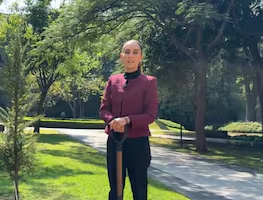Más Información

Noroña estalla contra sus "haters" en mensaje de fin de año; "lo único que saben destilar es odio, están jodidos"

Sheinbaum publica en el DOF reforma en materia de prisión preventiva oficiosa; entra en vigor el 1 de enero de 2025

Sheinbaum cierra el 2024 con mensaje de Año Nuevo; recuerda legado de AMLO y reafirma continuidad de la 4T
A tooth, a femur or skull, torn clothes stained with blood, any remains or belongings that help families reconcile with the absence of their beloved ones is the hope that holds together nearly 500 families in Iguala.
Their search has paid off: eleven of the 106 corpses found in about 60 clandestine graves have been identified. Eight families now know the fate of their missing children.
On October 8, 2014, Mayra Vergara, whose brother Tomás Vergara was kidnapped on July 5, 2012, challenged authorities along with her sister. At Iguala's main square she yelled: "Justice is for mass disappearances only?" That was the beginning. The inhabitants of Iguala fear drug traffickers, threats and the government itself, that prevents them from raising their voice. Nonetheless, “the other missing”, as Mayra named them in 2014, are being sought in the hills by their relatives themselves with the help of the Union of Peoples and Organizations of the State of Guerrero (UPOEG).
Miguel Ángel Jiménez Blanco, leader of the UPOEG, was killed on August 8, and some of the families looking for their missing relatives have received death threats.
The aid provided by the Executive Commission for the Attention of Victims (CEAV) is minimal. Each Tuesday they give 160 pesos (US$9.5 dollars) to the people coming to Iguala from other municipalities, and 100 pesos (US$6) to locals. The CEAV has not given any financial support to the children of missing people, even though the Victims Law states that they should get 300 pesos (US$17.9) per month until the child turns five, with a maximum of 1,700 pesos (US$101) for university students.
However no one gets this money because they would need to submit a “letter of absence” to the CEAV, which is only given if they pay 30,000 pesos (US$1,790) for an edict on a newspaper.







